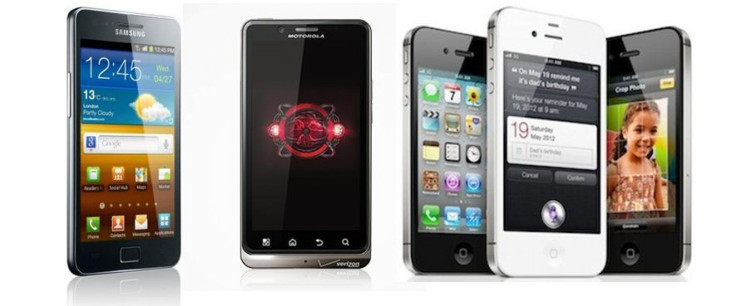Smartphone Shootout: Apple iPhone 4S vs. Motorola Droid Bionic vs. Samsung Galaxy S II
And the Winner is...

The Android series of phones have been dominating the smartphone world with a 42 percent ownership of the smartphone market share, according to Gartner. That is compared to Apple's control of 18 percent of the market.
But with the new iPhone 4S Apple could make some real strides on Google's Mobile OS. So to see how it stacks up, we've compared the iPhone 4S against some of the best Android powered phones out there: Motorola's Droid Bionic and Samsung's Galaxy S II.
Processor
All three phones sport a dual-core processor. The Galaxy clocks in as the fastest mobile device at 1.2 GHz. That edges out the 1GHz processing speed of the iPhone and Bionic. The iPhone 4S is powered by Apple's A5 chip and is supposed to be twice as powerful and deliver seven times faster graphics than the iPhone 4.
Screens and Sizes
The Galaxy and Bionic both have 4.3-inch screens. But the Bionic's 960-by-540 pixel screen is a little sharper than the Galaxy's 800-by-480 screen. The iPhone 4S has the tiniest 3.5-inch screen, but is the sharpest with 960-by-640 resolution.
The Galaxy is also the biggest phone with a height of 6 inches, a width of 2.6 inches and a depth of .4 inches, but weighs the least at 4.3 oz. That is compared to the dimensions of the iPhone at 4.5 by 2.3 by .4 inches and weight of 4.9 oz. Also the Bionic is 5 by 2.6 by .4 inches and weighs 5.6 oz.
Camera
All three phones have an 8-megapixel camera rear camera, an LED flash and are capable of 1080p video capture. The Bionic and iPhone both have VGA front cameras compared to the Galaxy's 2 megapixels.
Wireless Speed
The Bionic has the fastest speed supporting 4G LTE on Verizon's network. The Galaxy is the second fastest with HSPA+ 21, followed by the iPhone's 14.4 HSPA on AT&T or 3G EVDO Rev A on Sprints and Verizon. The iPhone 4S runs a little faster on the AT&T network versus Sprint and Verizon.
Mobile OS
The Bionic and Galaxy both run on Android's Gingerbread OS. It features a refined user interface from previous OS's, faster and more intuitive text inputs, better power management, near-field communication apps and Internet calling for those with SIP accounts. The iPhone 4S's new iOS 5 has a new safari reader, a new notification center, a great camera interface, iCloud, iMessage and the new Siri Voice Assistant App.
Though Android users can find Siri-like apps on the Android, they can't match Siri's functionality and personality. The Android OS might be able to match the individual functionality of the iOS 5, but it just can't be the amount of integration that is the basis of Apple's mobile OS.
Battery
The Galaxy has 11 hours of talk time compared to the Bionic's 10-and-a-half hours and 8 hours of talk time on the iPhone 4S. Also the Galaxy's battery is rated at 1650 milliampere-hours, the Bionic at 1735 mAh and the iPhone at 1420 mAh. Though the Bionic has more juice that 4G LTE really sucks up power.
Cost for Storage
Apple has the widest range of prices for models with different onboard hard drives. The iPhone 4S will cost $200 (16GB), $300 (32GB) and $400 (64GB). The Bionic costs $300 with 16GB of onboard storage and a 16GB microSD card pre-installed. The Galaxy costs $200 with 16GB of onboard storage and an empty microSD slot. A 32GB microSD card runs about $40 on Amazon.com.
The $200 price range will get buyers 16GB on the iPhone and the Galaxy. Apple also stays competitive with the Bionic for 32GB at the $300 price range. However, it is extremely pricy for more GB on the iPhone 4S and once you buy it you can't expand its memory at all. That being said the Galaxy and Bionic's memory can be expanded, but they can't touch the iPhone at its highest capacity.
Final verdict
It's sort of a tossup between the two Android phones. The both have similar screen sizes, storage capacities, and rear cameras. The Droid has faster wireless capability but also costs $100 more than the Galaxy. The Galaxy also has a slightly faster processor, a better front camera and is a little lighter. So the Galaxy is probably the smarter purchase since it is the most price efficient.
That being said it is hard to beat iPhone's iOS 5. It is a great mobile OS with a ton of nice polished features. Siri is a really powerful voice assistant that is just fun to use. iOS 5 offers a cohesive and consistent user experience across it's OS.
So if you want a technically better phone get an Android. But we're giving the nod to the iPhone 4S for its OS that is a great experience. At end of the day the interface is what matters most. But we'll see what happens when Android debuts Ice Cream Sandwich.
© Copyright IBTimes 2024. All rights reserved.




















